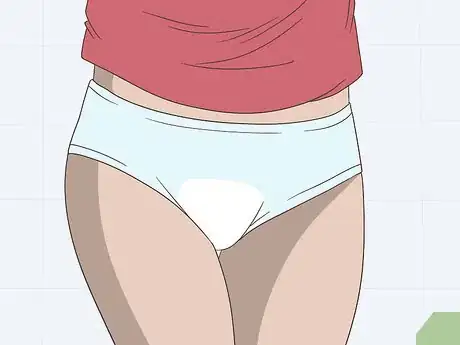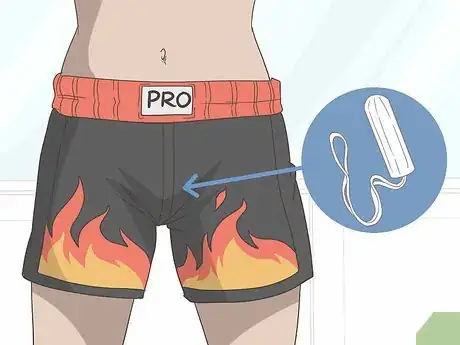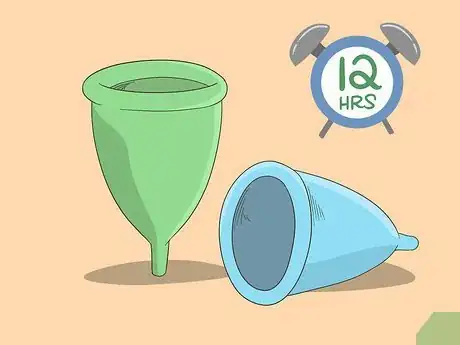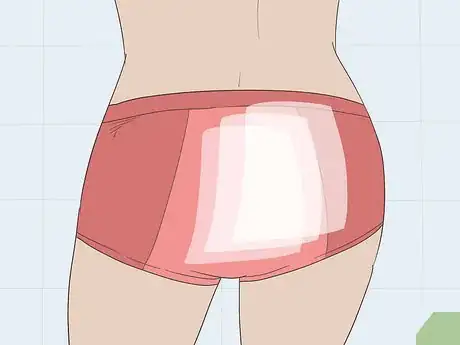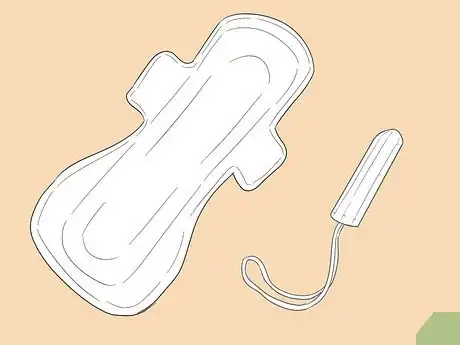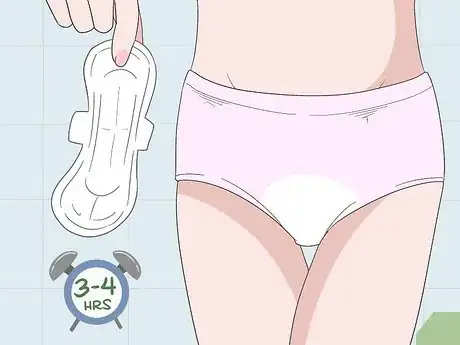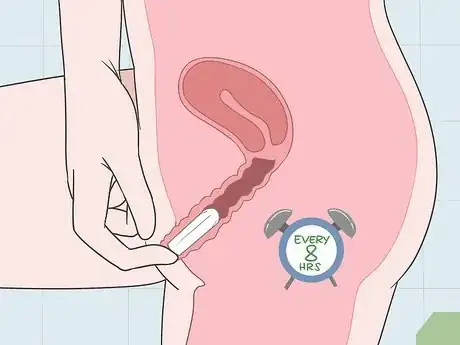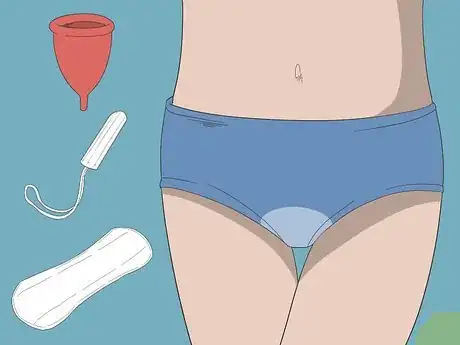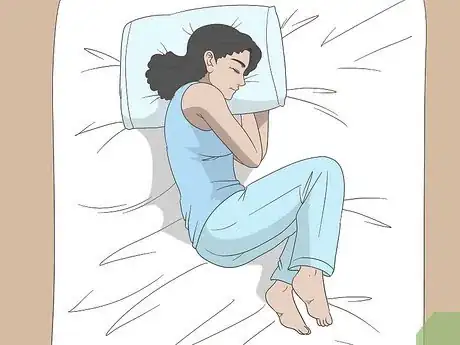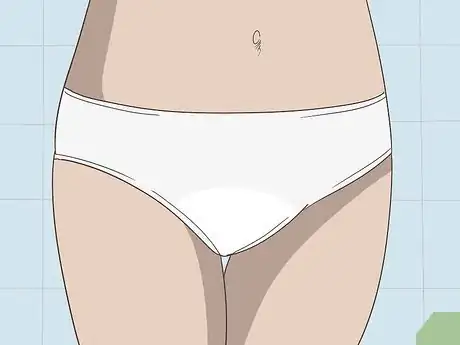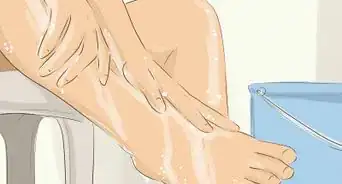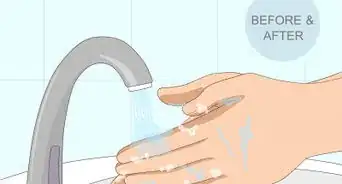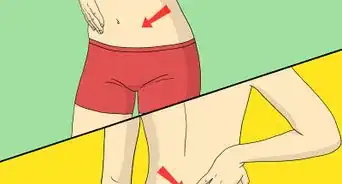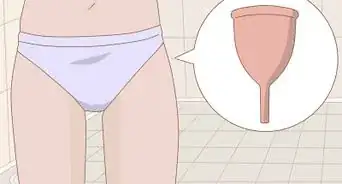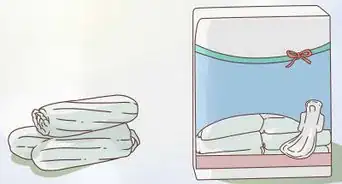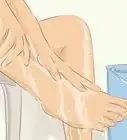This article was co-authored by Rebecca Levy-Gantt, MPT, DO and by wikiHow staff writer, Amber Crain. Dr. Rebecca Levy-Gantt is a board certified Obstetrician and Gynecologist running a private practice based in Napa, California. Dr. Levy-Gantt specializes in menopause, peri-menopause and hormonal management, including bio-Identical and compounded hormone treatments and alternative treatments. She is also a Nationally Certified Menopause Practitioner and is on the national listing of physicians who specialize in menopausal management. She received a Masters of Physical Therapy from Boston University and a Doctor of Osteopathic Medicine (DO) from the New York College of Osteopathic Medicine.
There are 8 references cited in this article, which can be found at the bottom of the page.
This article has been viewed 13,976 times.
Periods are already stressful because you have to deal with cramps, bloating, and fatigue. The last thing you want to worry about is a leak! Luckily, there are a lot of easy things you can do to prevent this from happening. Your first line of defense is using feminine hygiene products that can handle your flow and suit your lifestyle. On particularly heavy flow days, be sure to change your pad or tampon more frequently than usual. If you tend to experience leaks at night, try sleeping in the fetal position.
Steps
Choosing the Best Product for You
-
1Wear a sanitary pad with wings that can handle your flow. If maxi pads are your preferred choice, buy pads with wings that fold over the sides of your underwear to prevent leakage.
If your flow is heavy, go with maximum absorbency pads. If you choose a light pad that can't handle your flow, you may experience a leak.[1]
For best results, choose good quality pads that contain sticky material on the bottom of the wings to help hold them in place inside your panties. -
2Use a tampon if you play sports or plan to go swimming. Wearing a heavy pad while you're playing sports can be bulky and uncomfortable, and moving around a lot can shift your pad and cause a leak.
If you play sports or plan to swim on your period, tampons provide the best and most comfortable protection. A tampon is also virtually invisible when you're wearing a bathing suit.[2]
Tampons absorb water as well as menstrual blood when you go swimming, so change your tampon frequently to minimize the risk of leaking.
If you wear tight clothing like leotards and tights, avoid bulky pads and go with tampons.Advertisement -
3Try a menstrual cup to protect against leaks for up to 12 hours. If you’re looking for an alternative to tampons or pads that can be worn for up to 12 hours, using a menstrual cup may be the best option for you.
Menstrual cups are inserted into the vagina, so they're also very discreet and won't be visible if you're wearing a bathing suit or tight clothes.[3]
Menstrual cups are generally considered as or more effective than pads and tampons at preventing period leaks if inserted properly.[4]
If you sleep longer than 8 hours and don’t want to use pads or panty liners, a menstrual cup is a good option. -
4Try period panties for comfortable leak protection for up to 12 hours. Period panties generally look and feel almost exactly like regular underwear, but they contain several absorbent layers that catch and absorb menstrual blood very effectively.
If dealing with changing pads and tampons throughout the day is hard for you or you just want to eliminate the hassle, period panties might be more in line with your lifestyle.[5]
If you have to change clothes in front of other people, like in gym glass, it's unlikely that anyone will notice that you're wearing period panties.
Period panties come in a variety of styles, including hipsters and thongs, and a range of absorbencies. Most period panties are washable and can be worn up to 12 hours.
Minimizing the Risk of Leakage
-
1Use a thicker pad or larger tampon size on heavy flow days. If you’ve had issues with leaking before, using pads or tampons that are larger in size and absorbency may be a good option.
Every brand has a different way of designating the size and absorbency of their period products, so read the package carefully. In most cases, however, products accommodate light, moderate, or heavy flow days.[6]
Always use the lowest absorbency tampon you can without risking leaks. This helps reduce your risk of developing toxic shock syndrome (TSS).[7] -
2Change your pad every 3 to 4 hours to prevent overflow. This helps you avoid overusing a single pad, which can result in leaking. In addition, changing your pad every 3 to 4 hours helps prevent bad odors, particularly if you’re active while you’re wearing it, and bacterial infections.
- Period flows can be quite unpredictable. Changing your pad regularly helps protect you from leaks if your flow suddenly gets heavier.[8]
-
3Insert a new tampon every 4 hours to stay dry and healthy. Changing a tampon every few hours reduces the chance of your tampon overfilling and leaking out. It also reduces your risk of getting an infection or experiencing toxic shock syndrome (TSS), which is a very serious health issue.[9]
Taking Extra Precautions at Night
-
1Wear panty liners with tampons or cups for extra protection at night. If your flow is particularly heavy, wearing a panty liner with your usual tampon or cup provides another layer of leakage protection. When you’re asleep, you may not even be aware that your leaking until it's too late! Doubling up on products can prevent accidents from happening.[10]
- While panty liners may be more comfortable, you may need to wear a full pad with your tampon or cup if your flow is very heavy.
-
2Sleep in the fetal position to reduce night leakage. Lay on your side, stack your legs together, and bring your knees up a little closer to your tummy before you fall asleep. This can prevent leakage and may also help reduce cramps and bloating during the night.[11]
- In particular, try to avoid sleeping on your stomach. This puts pressure on your uterus and can cause more menstrual blood to come out, increasing the chance of leaking while you sleep.
- If you’re still worried, lay an old towel down under your body to protect your bottom sheet from stains.[12]
-
3Try tighter underwear to keep your pad in place if you toss and turn. Loose underwear may cause your pad to twist and move around, especially if you move around a lot in your sleep.
After a few hours of tossing and turning, even pads with adhesive bottoms and wings can detach and shift around, making leaking a lot more likely. Panties made of a stretchy material, like spandex, can help keep your pad firmly in place through the night.
Stretchy nylon and polyester panties are also good options. Avoid thongs at night, since they provide less coverage.
References
- ↑ https://www.plannedparenthood.org/learn/health-and-wellness/menstruation/how-do-i-use-tampons-pads-and-menstrual-cups
- ↑ https://www.plannedparenthood.org/learn/health-and-wellness/menstruation/how-do-i-use-tampons-pads-and-menstrual-cups
- ↑ https://uthealthaustin.org/blog/period-products
- ↑ https://www.nytimes.com/2019/07/16/health/menstrual-cup-periods-women.html
- ↑ https://www.bedsider.org/features/878-code-red-how-to-deal-with-period-leaks-and-spotting
- ↑ Rebecca Levy-Gantt, MPT, DO. Board Certified Obstetrician & Gynecologist. Expert Interview. 3 April 2020.
- ↑ https://www.fda.gov/consumers/consumer-updates/facts-tampons-and-how-use-them-safely
- ↑ https://kidshealth.org/en/teens/changing-pads.html
- ↑ Rebecca Levy-Gantt, MPT, DO. Board Certified Obstetrician & Gynecologist. Expert Interview. 3 April 2020.
